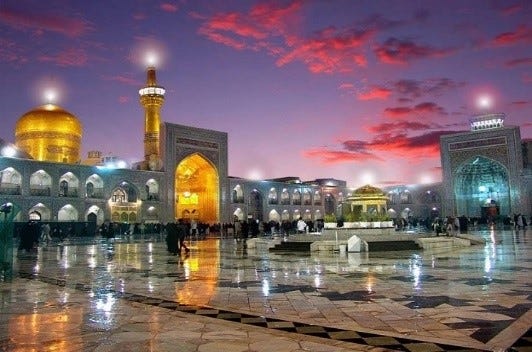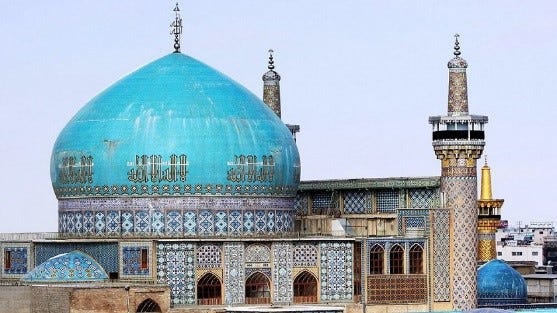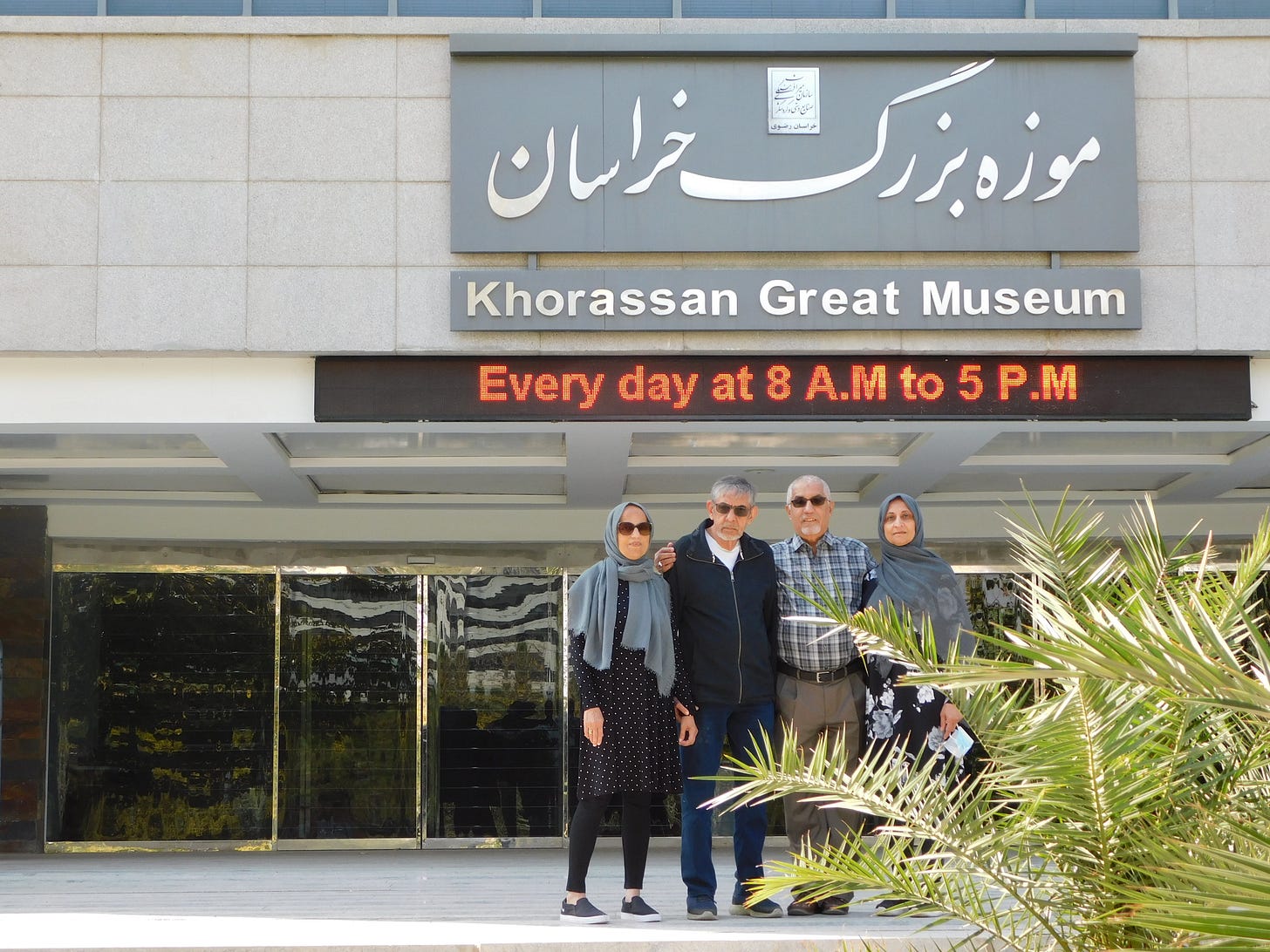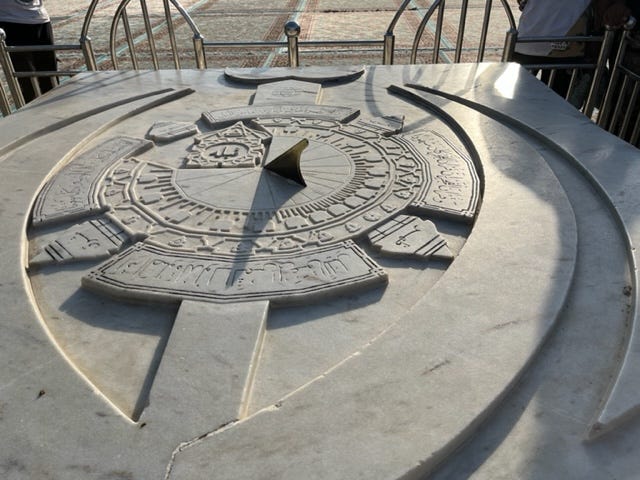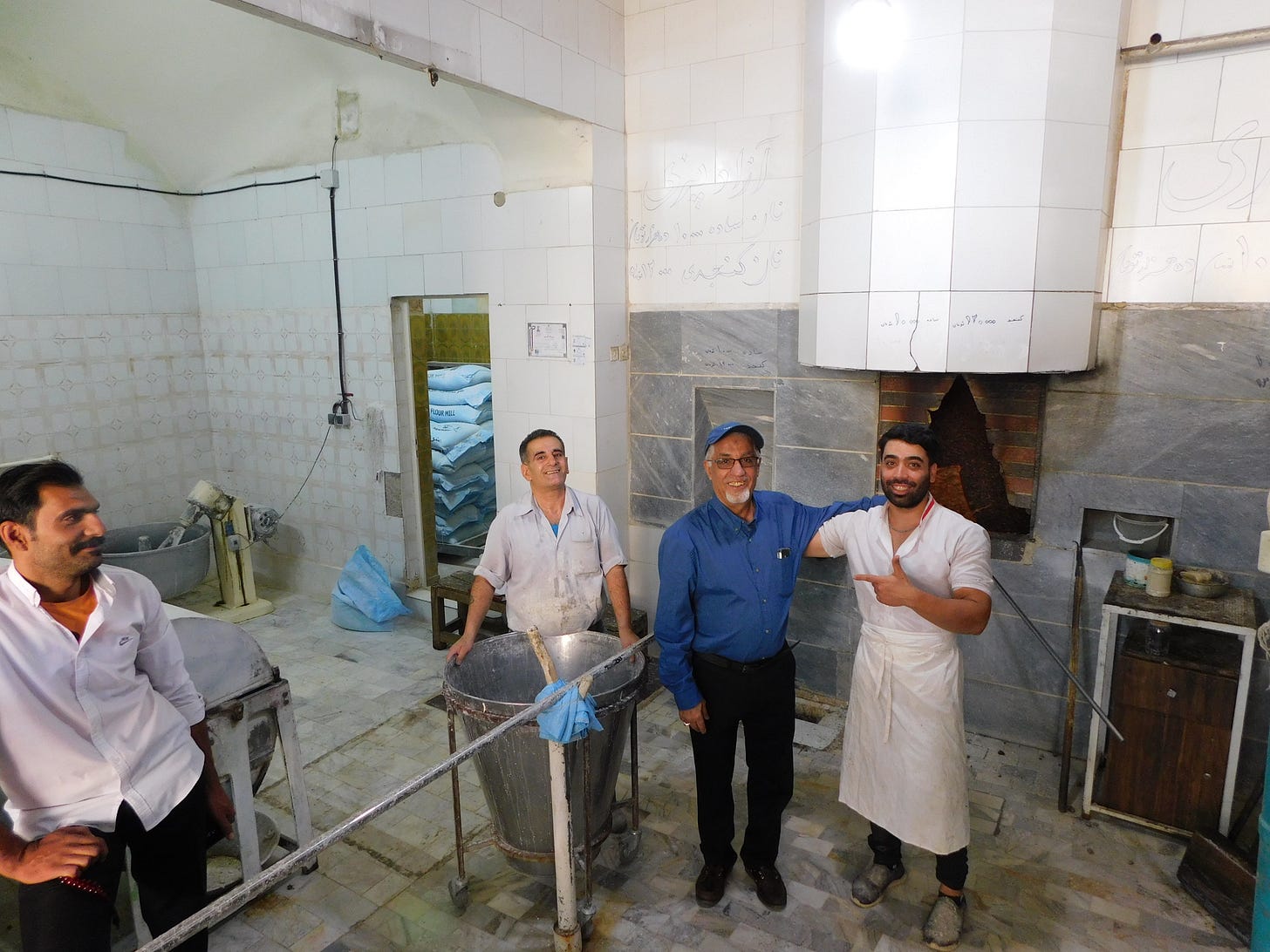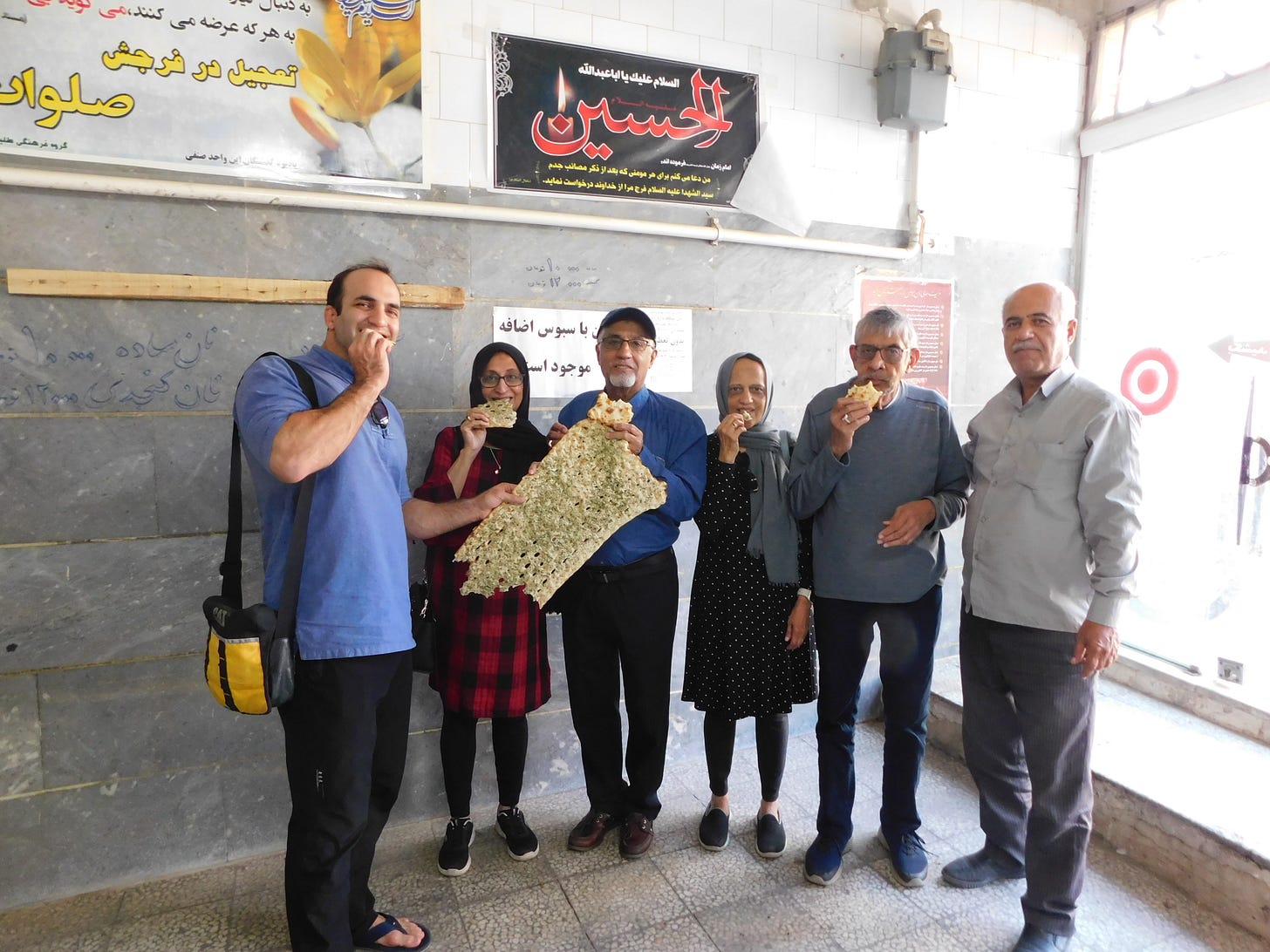Imam Reza's Holy shrine: A historical Architecture Masterpiece.
The structure is built by the distinguished architect of the Timurid period (1307 – 1507)
Qum is the center of Shi’i jurisprudence and clerical authority in Iran, but Mashhad serves as the nation’s spiritual capital for the Shia Muslims.
Imam Reza (as) shrine complex is visible from far away and has entrances from all sides. We arrived in Mashhad on Tuesday after 2:00 am, to check in at the Rizwan Hotel, which is 5 minutes walk away from the Haram.
Rizwan hotel has 4 stars plus rating with presence of numerous Bahrain groups. As per the manager, 80% of the people who stay here are from Bahrain. After the Bath (Ghusl) we walked to the Haram, the sight was magnificent and glorious. We could hear kettledrums.
What are Kettledrums?
In 860 H. When Baisonqor Shahrokh's son came to Mashhad from Herat to Haram to seek remedy from Imam Radha, kettle drums were beaten to announce his presence. Since then, this practice has been performed every day before sunrise.
All visitors are checked at the gates leading to the Shrine, but no cameras are allowed inside, but mobile phones are allowed and it is perfectly Ok to take pictures with a mobile phone. There are storage places (Amanah Room) where you can leave all not allowed objects.
You should leave your shoes at the shoe desk and get the TAG, because if you get lost in the Shrine, which you most likely will, the attendant will direct you to the shoe station. Just remember the gate you entered and the courtyard.
Almost everything about Mashhad relates to its role as the holiest city after Mecca, Medina, and Karbala. It is the capital of Iran’s Khorasan province with over three million people and the second most populous city in Iran.
The holy shrine of Imam Reza (as) has long been by far the most visited religious destination in Iran attracting domestic and international visitors each year.
Mashhad is in the northeast of the country, close to the borders of Turkmenistan and Afghanistan. It was a major oasis along the ancient Silk Road.
Mashhad is the burial place of our beloved eight Imam Musa Al Reza (as) who was poisoned by the caliph of the time. Over the next thousand years, the shrine complex was leveled, ransacked, and rebuilt several times depending on the ruling army of the day.
We were very fortunate to get a complete tour of the complex by Hujjat al-Islam Rasool Salman, the Chief librarian Sayed Saber Marjayi, Master Khosh Kholgh and the director of the Astan Qods Razavi (AQR not present in the picture) – The Islamic Propagation Dept.
We also had an opportunity to wash the 99 names of Allah’s monuments (picture above).
The Sanctuary of Imam Reza contains the mausoleum of the eighth Imam, the Goharshad mosque, a museum, a library, four seminaries, a cemetery, Razavi University, a dining hall for pilgrims, and numerous prayer halls.
The Central Museum of Khorasan has a gigantic park and museum which has coins, stamps, ancient clocks, ancient windmills to grind flour, astronomical instruments, ancient marine animals, fish, and hundreds of art objects.
The museum has the first old wooden tombs of Imam Reza’s shrine and pictures dating back to the beginning of photography in Iran.
There is also a Carpet Museum and a Quran Museum which we did not get an opportunity to visit.
However, we got a golden opportunity from the Bharani group in our hotel who invited us to the Milad-un-Nabi celebrations. What a celebration, with speech and mawlid in Arabic and ending with Islamic jeopardy questions with prizes
The most interesting thing in the shrine complex was the Sa’at clock which is in the courtyard of Inqilab. It dates to the period of Mozzaffar-al-Din Shah’s period in 1896, the Qajar dynasty.
The shrine complex is a lighted magical city-within-a-city with clusters of domes and minarets in blue and pure gold and numerous courtyards.
Imam Reza (as) shrine is one of the best spiritual places on earth. No words describe how beautiful this place is! Every piece of architecture tiles, mirrors, stones, ceiling, painting, etc. are configured to Octagon – the eight Imam
One of the most beautiful places I have ever seen in my life, amazing! This is one of the holiest sites for Shia Islam, and its beauty, splendor, and majesty do it justice.
The shrine itself covers an area of 267,079 square meters (2,874,810 sq. ft.) while the seven courtyards which surround, cover an area of 331,578 square meters
A truly magnificent series of almost never-ending spectacular courtyards and sanctuaries. Over the years numerous courtyards were built like Sahn-e Qods - the Qods Courtyard.
It was opened to the public in 1990, named after Jerusalem (Quds), and built in the shape of the dome of the rock in Jerusalem. The architecture and mosaic tile work are a replica of Masjid-e Aqsa and its dome is completely composed of gold.
One wonders when will the Arab monarchies, dictatorial regimes and the Kings ever liberate Al Quds – Jerusalem? Road to liberate Al Quds is via Mecca and Medina.
The shrine is awesome and peaceful. Miracles are witnessed, hence it is called the "Land of miracles.” I just love the place and wish I could have spent more time. An Absolute must visit… Breathtaking beauty.
This is a must-visit place for everyone. You will be impressed by the fascinating architecture, tile work, mirror work, gold coating, colors, and numerous courtyards. Whether you are religious or not, you will still enjoy visiting this place.
The Imam Reza Shrine complex, also known as the Haram, is located at the heart of the city of Mashhad. It is the second-largest city in Iran, with over three million inhabitants.
Mashhad owes much of its significance to Imam Reza’s shrine, which has been built and rebuilt numerous times over the course of history, and gradually the city became a center of commerce and travel in the region.
It was not until the Timurid period (1307–1507 CE) that the shrine complex and the city experienced substantial growth. The Sultan’s wife Ghor Shad (d. 1457) was responsible for commissioning the mosque to be built - the architectural jewel of the shrine complex.
Upon coming to power in 1501, the Safavids declared Iran a Shi’i state, and Shah Abbas 1st the first Safavid ruler to devote resources for renovations to the shrine complex after making the pilgrimage from his capital of Isfahan to Mashhad on foot in 1597.
People should cease and deceit criticizing the walk from Najaf and Karbala nor it is a Bida. The MEGA Bida is the Halloween celebration in the holiest land of Mecca – the cradle of Islam.
Everywhere around the shrine complex, cranes dominate the skyline building new accommodations and hotels for the increasing number of pilgrims. Despite sanctions, Mashhad has prospered. It is a miracle.
The Imam Reza Shrine has grown significantly over the centuries from a small shrine over the grave of the 8th Imam into one of the largest religious complexes in the Islamic World.
The atmosphere and the environment is very peaceful and spiritual. There are thousands of shops. I recommend you buy Feroza turquoise from Nishapur. Saffron, and other items from Mashhad.
The shop owner in Nishapur was so humble and hospitable that he gave us tea and dessert. He gave me the picture frame of Imam Khomeini and Khamenei, which I had to give away as a gift in Qum because I just did not have room to carry.
Thursday night is the most spiritual and beautiful. I do not find words to explain this experience. It was a wonderful experience that is beyond my expression.
One of the most spiritual experiences was the opportunity to sit in the haram during the recitation of Dua-e-Kumail recited in the most beautiful and melodious voice with the eulogy of Ashura and Karbala. People crying and joining in sync for recitation.
When reading duas, and Ziyarat, the pigeons and the birds would always be circulating through corridors of the courtyards to pay respect to Imam Reza (as) and may be listening to the beautiful supplications.
While sitting in the courtyard of Jamhuri-e-Islam I would find kids sleeping peacefully, while elder siblings taking care to cover them with blankets, so as not to feel cold or feeding. Masha ‘Allah, what a beauty!
As I was about to leave the Shrine after morning prayers, I heard beautiful voices singing in unison. Suddenly a group of men appear sweeping the floor and singing poetry in Farsi in the dedication of Imam Reza and the bystanders will join.
I was overwhelmed with emotion and tears just ran down my cheeks with joy. And all I heard was “Khuda Hafez”, "Mam'noon and “Khahesh Mikonam” (thank you), “Mersi” (3 times thanks), and “Kheilil Lotf Darid” (that’s very kind.)
Apart from the Imam Reza shrine, there are several sightseeing tombs of historical celebrities like poet Ferdowsi and the disciples are buried in nearby Tus and Nishapur.
There are public baths, which have been restored and turned into museums. These public baths were built during the Safavid era in 1648, which is an outstanding example of the architecture of that period.
Shopping in Mashhad is the best experience where you can get everything under the sky very cheaply. Thousands of shopkeepers selling the same items, and Allah the most merciful provides sustenance to all the shopkeepers who were jubilant with smiles
The streets were bursting with people, while money changers lined up on Imam Reza Street giving the best rates compared to the hotels and banks.
Iran is the land of the world's greatest ancient empires with one of the best cuisines in the world. Many might have heard about Persian carpets, Saffron, pistachio, historic monuments, etc., but less is known about its diverse, and mysterious cuisine.
Our guides took us to best of the best restaurants with such cuisines likes Zareshk Polo, Tahchin (baked rice cake) Dizi (Abgusht), Kabab Koobideh, Doogh (yogurt drink), Bastani Sonnati (Saffron ice cream with Faloodeh), and black tea (Chai) with Nabat (yellow sugar candy)
There were numerous types of soup (Aush). The ones I liked were Ash-e-Anar (pomegranate), Ash-e-Jo (barley) and Ash-e-sak (spinach stew). A very good healthy food.
There are more than thirty different kinds of bread available in Iran, but Sangak bread, Barbari, Taftoon, and Lavash are the most popular Iranian breads, consumed all over the country. I like the Sangak bread which is a preferred option for diabetic.
You can find lots of great restaurants and all kinds of fast food are available too. Picture of Sangak Stone Bread Making.



